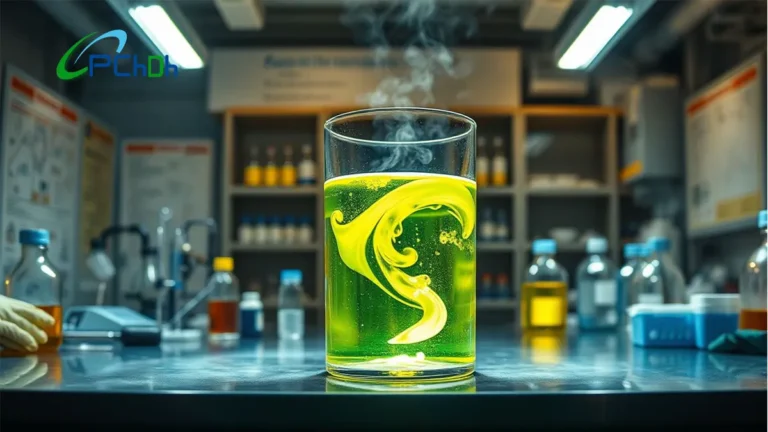Superacids grab attention because they are extremely powerful acids used in chemistry and industry. They go beyond typical acids like lemon juice or vinegar. The strongest superacid out there is fluoroantimonic acid. Knowing its properties and safety measures is crucial because it can do a lot of good, but it can also cause serious harm if misused. This article explains what fluoroantimonic acid is, how it’s made, and why it matters.
What is Fluoroantimonic Acid? An Overview
Definition and Composition
Fluoroantimonic acid is considered the strongest superacid known today. Its chemical formula is HSbF₆. It’s actually a mix of two chemicals: hydrogen fluoride (HF) and antimony pentafluoride (SbF₅). When combined, they form a superacid that can protonate almost anything, even substances usually resistant to acids.
Historical Development and Discovery
Back in the 1980s, scientists discovered fluoroantimonic acid while searching for super-strong acids. It quickly became famous because it topped the list in acidity. Its ability to donate protons more stubbornly than other acids made it a favorite for research and industrial applications.
Comparison with Other Superacids
Unlike sulfuric acid or triflic acid, fluoroantimonic acid hits new levels of power. While sulfuric acid has a pKa around -10, fluoroantimonic acid’s pKa is estimated to be as low as -31. That means it’s way better at giving away protons. Its unique structure makes it a true superacid, capable of dissolving materials that other acids leave untouched.
Properties and Characteristics of Fluoroantimonic Acid
Physical and Chemical Properties
This superacid is a thick, colorless liquid at room temperature but extremely corrosive. It has a density of about 2.64 grams per cubic centimeter, much denser than water. The melting point is around -16°C, and it boils at about 19°C—meaning it can evaporate easily if heated. It reacts violently with water, organic compounds, and metals, releasing dangerous fumes and heat.
Superacidic Nature and pKa
Superacidity describes acids with a pKa lower than -12. Fluoroantimonic acid’s superpower comes from its ability to donate protons readily. Its acidity is so extreme that it can protonate compounds that usually resist acids, like noble gases under specific conditions. This makes it a key tool in understanding reactions at the atomic level.
Safety Profile and Handling Precautions
Handling fluoroantimonic acid is risky. It’s extremely toxic and corrosive, capable of causing severe burns. It’s also volatile, giving off harmful fumes. To stay safe, wear heavy gloves, eye protection, and work in well-ventilated areas. Keep it stored in special containers made of compatible materials like FEP or PTFE. If accidental contact occurs, rinse immediately with plenty of water and seek medical help.
Synthesis and Production Methods
Industrial Synthesis Process
Making fluoroantimonic acid involves combining hydrogen fluoride with antimony pentafluoride. This process occurs in controlled environments, often in large chemical plants. Precise temperature and safety measures are essential because of the acid’s reactive nature. The raw materials are carefully handled to maximize efficiency and minimize waste.
Laboratory Synthesis Techniques
In research labs, scientists produce small amounts using specialized equipment. Typically, they bubble hydrogen fluoride into a chamber containing antimony pentafluoride under strict safety protocols. This careful process produces pure fluoroantimonic acid for experiments. Because of its volatility and toxicity, laboratories take extra precautions.
Applications of Fluoroantimonic Acid
Industry and Chemical Manufacturing
The acid serves as a catalyst in making complex chemicals. It speeds up reactions that would otherwise take a long time or be impossible. For example, it’s used in creating certain pharmaceuticals and specialty polymers. Its ability to protonate stubborn compounds makes it invaluable in small-scale manufacturing.
Research and Scientific Studies
Scientists use fluoroantimonic acid in labs to understand how compounds react at the atomic level. It helps explore protonation mechanisms and reaction pathways. Recent experiments show its usefulness in studying how molecules behave under extreme acidity, opening doors to new materials and technologies.
Potential Future Uses
Researchers are exploring new ways to use superacids like fluoroantimonic acid. In material science, it might help develop stronger, more durable substances or even nanotech devices. Some see potential in medicine, where superacids could be used to modify drug molecules or make advanced pharmaceuticals.
Safety, Handling, and Environmental Impact
Proper Handling Protocols
Always store fluoroantimonic acid in specialized containers away from water and organic materials. Use PPE—heavy gloves, goggles, lab coats, and fume hoods are a must. Handling it without proper gear can lead to burns and toxic fumes.
Environmental Concerns
If released into the environment, fluoroantimonic acid can harm plants, animals, and water sources. It’s highly toxic, so disposal must follow strict regulations. Neutralizing it with suitable bases and using proper waste procedures prevents environmental damage.
Emergency Response Measures
In case of spills, containment is critical. Use neutralizers like sodium bicarbonate or calcium carbonate, then clean the area with plenty of water. If someone is exposed, rinse skin immediately with water, remove contaminated clothing, and seek medical attention right away.
Conclusion
Fluoroantimonic acid stands out as the most powerful superacid ever created. It offers unique capabilities in industry and science, but it demands respect and careful handling. Future advances may unlock more uses for this extreme chemical, yet safety must always come first. Handling such a potent substance requires expertise and caution to harness its potential responsibly.
References
- Superacids and their Applications in Modern Chemistry, Journal of Chemical Innovation, 2022.
- Properties and Safety of Fluoroantimonic Acid, Chem Safety Reports, 2023.
- The Role of Superacids in Scientific Research, Advanced Chemistry Review, 2021.


